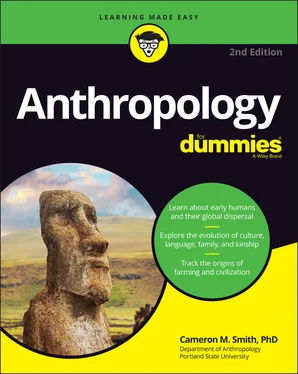The fruit-eaters: Frugivores
The frugivores (fruit-eaters) focus on fruit, but they eat other things as well. Among the most frugivorous primates are the apes, and of these, the most fruit-obsessed are the orangutans, which devour large quantities of the custard-like durian fruit as well as the leaves, fruit, and seeds of nearly 400 other plant species. The frugivores have a sweet tooth, focusing on sugary plant products, and they display the following characteristics:
Generally large size (compared to most primates), averaging over 10 kilograms (20 pounds)
A diurnal lifestyle, being active mainly at day
Mixed sharp and flat teeth for processing vegetation (but sometimes with particularly large incisors for opening up tough-skinned fruit)
Of the more striking characteristics of the frugivores is their good memory. They’re very good about remembering just where good patches of fruit appear each year and therefore spend a little less time foraging in search of food than some other primates. This skill can have important (if currently unknown) effects on variables like the complexity of social interactions because they spend more time sitting, grooming, and feeding together than traveling in search of food.
Monkeying Around: Primate Locomotion
How primates locomote — get from place to place — is fascinating, and it can tell you a lot about how they live. Some leap from limb to limb, others swing like trapeze artists, and of course humans walk on two feet (unless you’re a pirate or something). I discuss the main types of locomotion in the following sections; they’re illustrated in Figure 4-5.

Illustration courtesy of Cameron M. Smith, PhD
FIGURE 4-5:The main types of locomotion.
Stand back, Tarzan: The brachiators
Brachiation is swinging from one hold (like a tree limb) to another, and the speed champion species here is the gibbon. Southeast Asian gibbons can swing through forest canopy at more than 30 miles per hour, about ten times as fast as most humans walk. Slower brachiators are the big, heavy orangutans, who hang, reach, and shift their body weight instead of really smoking through the canopy like the gibbons. Brachiators have several main anatomical characteristics:
Long arms: The longer the muscle, the greater its power, so evolution has selected for longer and more powerful arms over time.
Short, relatively weak legs: These animals don’t spend much time on the ground and really prefer to hang from their hands.
Very powerful hands: These primates have strong, long fingers but very small thumbs; thumbs would get in the way of the hooking action used to grasp tree limbs and vines.
Bug-bashers: The vertical-clingers-and-leapers
The vertical-clingers-and-leapers (VCLs) do just that: They hug tight to a tree trunk, with their spine vertical, until they’re ready to move, and then they twist at the waist and push off hard with their legs, leaping at their target. That target is often an insect, a juicy treat that makes up a large part of their diet. The VCLs include the tarsiers and the lemurs, both members of the prosimian group discussed earlier in the chapter. Their anatomical characteristics include
Short, weak arms because they propel with their legs
Strong legs for powerful leaping
In the trees: Arboreal quadrupeds
Moving quadrupedally means moving on four legs or feet, and it’s how many monkey species get around. It involves using both the hands and feet to grasp relatively horizontal tree limbs, which they walk on with great skill and a seemingly daredevil attitude. But evolution has shaped their instincts and abilities, and although accidents happen, they’re infrequent enough not to have extinguished this kind of locomotion. The arboreal quadrupeds have the following anatomical characteristics:
Strong arms and legs.
Relatively low body weight (most of them).
A divergent big toe, such that their feet look much like our hands, with the big toe sticking off to the side; this allows the feet to be used like hands, to grasp tree limbs.
A prominent tail (in most species) used as a balance; one kind of primate, the spider monkey, has a prehensile tail that can be carefully controlled to wrap around objects and hold them, just like a hand.
Soldiers beware: Terrestrial quadrupeds
The terrestrial quadrupeds get around on all fours, but on the ground rather than habitually in the trees. These animals include the baboons, which live in large, complex social groups (troops) and can be fearsome to humans. One troop in South Africa particularly disliked one turn-of-the-century British officer and regularly pelted him — and only him — whenever they saw him marching his own troops! The terrestrial quadrupeds have the following attributes:
Moderately strong arms and legs
Lack of massive upper- or lower-body build for either brachiating or clinging-and-leaping
Calloused feet, hands, and buttocks from spending so much time on the ground
Technically, the chimps and gorillas mix things up a little: They spend a lot of time on the ground, so they’re officially terrestrial quadrupeds, but they have the bodies of arboreal quadrupeds because they’ve only recently (in evolutionary time) come down from the trees in a substantial way. They have one important distinguishing characteristic: heavily built, locking knuckles that allow the heavy upper body to be supported with the knuckles of the hands by pressing down on the ground.
Other primates do some locomotor mixing as well. Bonobos, a kind of West African chimpanzee, are terrestrial quadrupeds, but they also spend some time brachiating and even walking on two legs. This walking is different than human walking, though, because the bonobos only do it on occasion, which is called opportunistic locomotion. Humans walk habitually , meaning their anatomy is adapted for this kind of locomotion.
THE GREAT WOMEN OF GREAT APE STUDIES
A great deal of what anthropology currently knows about the apes has come from long-term field studies carried out by some remarkable women. Jane Goodall began as a student of anthropologist Louis Leakey, who encouraged her to study the chimpanzees to better understand humanity. She did and for 45 years has observed these primates in great detail at a research station at Gombe, Tanzania. Recently Goodall has shifted from studying the chimpanzees to advocating for protection of chimpanzee habitat; like the other apes, the chimpanzee is endangered.
Another great ape, the orangutan of Borneo, has been studied for more than 30 years by Biruté Galdikas of Canada’s Simon Fraser University. Like Goodall, today Galdikas argues forcefully for protection of orangutan habitat, which is being deforested at an alarming rate; some estimate that the orangutan will be extinct by 2012. Dian Fossey (who, like Galdikas and Goodall, was also inspired by Louis Leakey) studied gorillas for nearly three decades, but she was murdered under mysterious circumstances in 1985, and today the gorilla is also becoming extinct, facing the deforestation of its habitat as well as a threat from the Ebola virus. For more on the extinction of primates, see the section “Primates Today (But For How Long?)” later in the chapter.
One of the most important things these women did was to study apes in the wild — not in zoos; you can imagine how different ape behavior would be in these situations. Remember, though, that even the observer’s presence would effect ape behavior, so rather than saying they were observing wild apes, anthropologists say they were studying habituated apes, apes that were accustomed to seeing human observers. Exactly what effects the observers have on ape behavior in non-zoo settings is debatable, but it’s very likely to be more “natural” than zoo behavior.
Читать дальше













